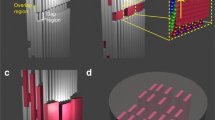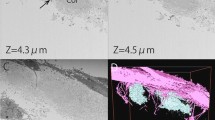Abstract
Bone is a composite material in which collagen fibrils form a scaffold for a highly organized arrangement of uniaxially oriented apatite crystals1,2. In the periodic 67 nm cross-striated pattern of the collagen fibril3,4,5, the less dense 40-nm-long gap zone has been implicated as the place where apatite crystals nucleate from an amorphous phase, and subsequently grow6,7,8,9. This process is believed to be directed by highly acidic non-collagenous proteins6,7,9,10,11; however, the role of the collagen matrix12,13,14 during bone apatite mineralization remains unknown. Here, combining nanometre-scale resolution cryogenic transmission electron microscopy and cryogenic electron tomography15 with molecular modelling, we show that collagen functions in synergy with inhibitors of hydroxyapatite nucleation to actively control mineralization. The positive net charge close to the C-terminal end of the collagen molecules promotes the infiltration of the fibrils with amorphous calcium phosphate (ACP). Furthermore, the clusters of charged amino acids, both in gap and overlap regions, form nucleation sites controlling the conversion of ACP into a parallel array of oriented apatite crystals. We developed a model describing the mechanisms through which the structure, supramolecular assembly and charge distribution of collagen can control mineralization in the presence of inhibitors of hydroxyapatite nucleation.
This is a preview of subscription content, access via your institution
Access options
Subscribe to this journal
Receive 12 print issues and online access
$259.00 per year
only $21.58 per issue
Buy this article
- Purchase on SpringerLink
- Instant access to full article PDF
Prices may be subject to local taxes which are calculated during checkout





Similar content being viewed by others
References
Hulmes, D. J. S., Wess, T. J., Prockop, D. J. & Fratzl, P. Radial packing, order, and disorder in collagen fibrils. Biophys. J. 68, 1661–1670 (1995).
Traub, W., Arad, T. & Weiner, S. 3-dimensional ordered distribution of crystals in turkey tendon collagen-fibers. Proc. Natl Acad. Sci. USA 86, 9822–9826 (1989).
Hodge, A. J. & Petruska, J. A. in Aspects of Protein Structure (ed. Ramachandran, G. N.) 289–300 (Academic, 1963).
Miller, A. Collagen: The organic matrix of bone. Phil. Trans. R. Soc. B 304, 455–477 (1984).
Orgel, J. P. R. O., Irving, T. C., Miller, A. & Wess, T. J. Microfibrillar structure of type I collagen in situ. Proc. Natl Acad. Sci. USA 103, 9001–9005 (2006).
Glimcher, M. J. & Muir, H. Recent studies of the mineral phase in bone and its possible linkage to the organic matrix by protein-bound phosphate bonds. Phil. Trans. R. Soc. B 304, 479–508 (1984).
Landis, W. J., Song, M. J., Leith, A., Mcewen, L. & Mcewen, B. F. Mineral and organic matrix interaction in normally calcifying tendon visualized in 3 dimensions by high-voltage electron-microscopic tomography and graphic image-reconstruction. J. Struct. Biol. 110, 39–54 (1993).
Mahamid, J. et al. Mapping amorphous calcium phosphate transformation into crystalline mineral from the cell to bone in zebrafish fin rays. Proc. Natl Acad. Sci. USA 107, 6316–6321 (2010).
Traub, W., Arad, T. & Weiner, S. Origin of mineral crystal-growth in collagen fibrils. Matrix 12, 251–255 (1992).
George, A. & Veis, A. Phosphorylated proteins and control over apatite nucleation, crystal growth, and inhibition. Chem. Rev. 108, 4670–4693 (2008).
Maitland, M. E. & Arsenault, A. L. A correlation between the distribution of biological apatite and amino-acid-sequence of type-I collagen. Calcif. Tissue Int. 48, 341–352 (1991).
Berthet-Colominas, C., Miller, A. & White, S. W. Structural study of the calcifying collagen in turkey leg tendons. J. Mol. Biol. 134, 431–445 (1979).
Katz, E. P. & Li, S. Structure and function of bone collagen fibrils. J. Mol. Biol. 80, 1–15 (1973).
Landis, W. J. & Silver, F. H. Mineral deposition in the extracellular matrices of vertebrate tissues: Identification of possible apatite nucleation sites on type I collagen. Cells Tissues Organs 189, 20–24 (2009).
Pouget, E. M. et al. The initial stages of template-controlled CaCO3 formation revealed by cryo-TEM. Science 323, 1455–1458 (2009).
Stetlerstevenson, W. G. & Veis, A. Type-I collagen shows a specific binding-affinity for bovine dentin phosphophoryn. Calcif. Tissue Int. 38, 135–141 (1986).
Stetlerstevenson, W. G. & Veis, A. Bovine dentin phosphophoryn—calcium-ion binding-properties of a high-molecular-weight preparation. Calcif. Tissue Int. 40, 97–102 (1987).
Deshpande, A. S. & Beniash, E. Bioinspired synthesis of mineralized collagen fibrils. Cryst. Growth Des. 8, 3084–3090 (2008).
Olszta, M. J. et al. Bone structure and formation: A new perspective. Mater. Sci. Eng. R. 58, 77–116 (2007).
Price, P. A., Toroian, D. & Lim, J. E. Mineralization by inhibitor exclusion: The calcification of collagen with fetuin. J. Biol. Chem. 284, 17092–17101 (2009).
Fratzl, P., Fratzl-Zelman, N. & Klaushofer, K. Collagen packing and mineralization—an X-ray-scattering investigation of turkey leg tendon. Biophys. J. 64, 260–266 (1993).
Beniash, E., Traub, W., Veis, A. & Weiner, S. A transmission electron microscope study using vitrified ice sections of predentin: Structural changes in the dentin collagenous matrix prior to mineralization. J. Struct. Biol. 132, 212–225 (2000).
Hodge, A. J. & Schmitt, F. O. The charge profile of the tropocollagen macromolecule and the packing arrangement in native-type collagen fibrils. Proc. Natl Acad. Sci. USA 46, 186–197 (1960).
Chapman, J. A., Tzaphlidou, M., Meek, K. M. & Kadler, K. E. The collagen fibril—a model system for studying the staining and fixation of a protein. Electron Microsc. Rev. 3, 143–182 (1990).
Jee, S. S., Culver, L., Li, Y. P., Douglas, E. P. & Gower, L. B. Biomimetic mineralization of collagen via an enzyme-aided PILP process. J. Cryst. Growth 312, 1249–1256 (2010).
Rochette, C. N. et al. A shielding topology stabilizes the early stage protein-mineral complexes of fetuin-a and calcium phosphate: A time-resolved small-angle X-ray study. Chembiochem 10, 735–740 (2009).
Toroian, D., Lim, J. E. & Price, P. A. The size exclusion characteristics of type I collagen—implications for the role of noncollagenous bone constituents in mineralization. J. Biol. Chem. 282, 22437–22447 (2007).
Kawska, A., Hochrein, O., Brickmann, A., Kniep, R. & Zahn, D. The nucleation mechanism of fluorapatite-collagen composites: Ion association and motif control by collagen proteins. Angew. Chem. Int. Ed. 47, 4982–4985 (2008).
He, G. & George, A. Dentin matrix protein 1 immobilized on type I collagen fibrils facilitates apatite deposition in vitro. J. Biol. Chem. 279, 11649–11656 (2004).
He, G. et al. Spatially and temporally controlled biomineralization is facilitated by interaction between self-assembled dentin matrix protein 1 and calcium phosphate nuclei in solution. Biochemistry 44, 16140–16148 (2005).
Posner, A. S. & Betts, F. Synthetic amorphous calcium phosphate and its relation to bone mineral structure. Acc. Chem. Res. 8, 273–281 (1975).
Acknowledgements
We thank G. Falini (University of Bologna, Italy) for kindly providing the horse tendon collagen; L. B. Gower (University of Florida, Florida, USA) for a critical review of the manuscript; S. Weiner (Weizmann Institute of Science, Israel) and J. P. R. O. Orgel (Illinois Institute of Technology, Illinois, US) for helpful discussions; and J. van Roosmalen (Eindhoven University of Technology, The Netherlands) for his help with the tomography reconstructions. Supported by the Dutch Science Foundation, NWO, The Netherlands and by the European Community (FP6, project code NMP4-CT-2006-033277 TEM-PLANT).
Author information
Authors and Affiliations
Contributions
F.N. carried out most experiments and co-wrote the manuscript. K.P. and P.A.J.H. carried out the molecular modelling. A.G. provided the C-DMP1 and the expertise in the work with the protein. L.J.B. contributed to the development of the mineralization experiments for cryoTEM. P.H.H.B. provided support with the cryoTEM. H.F. provided support with the tomographic reconstructions. G.W. and N.A.J.M.S. supervised the project and N.A.J.M.S. co-wrote the manuscript. All authors discussed the results and revised the manuscript.
Corresponding author
Ethics declarations
Competing interests
The authors declare no competing financial interests.
Supplementary information
Supplementary Information
Supplementary Information (PDF 3121 kb)
Supplementary Information
Supplementary Movie 1 (MOV 9215 kb)
Supplementary Information
Supplementary Movie 2 (MOV 7532 kb)
Rights and permissions
About this article
Cite this article
Nudelman, F., Pieterse, K., George, A. et al. The role of collagen in bone apatite formation in the presence of hydroxyapatite nucleation inhibitors. Nature Mater 9, 1004–1009 (2010). https://doi.org/10.1038/nmat2875
Received:
Accepted:
Published:
Issue Date:
DOI: https://doi.org/10.1038/nmat2875



